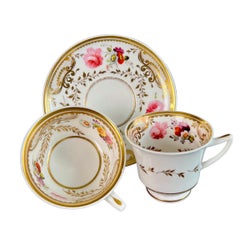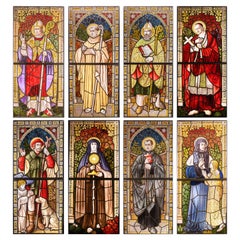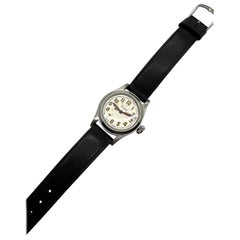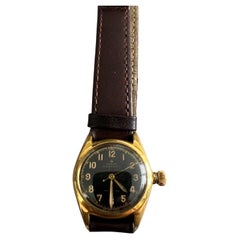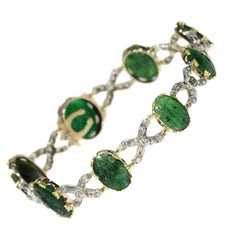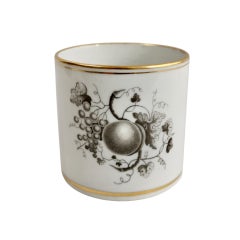How Can You Identify Antique Glass
H&R Daniel Teacup Trio, White, Floral, Etruscan Shape, Regency circa 1825
By H&R Daniel
Located in London, GB
. Daniel porcelain can be hard to identify as the factory was only around for about two decades, but this
Category
1820s English Rococo Revival How Can You Identify Antique Glass
Materials
Porcelain
Free Shipping
H 1 in Dm 1 in
Selection of eight restored 19th C Neo-Gothic Stained-Glass Windows
Located in Leuven , BE
The Color Experience: Stained-glass windows
“Color is a power which directly influences the soul
Category
19th Century Belgian Gothic Revival How Can You Identify Antique Glass
Materials
Art Glass, Stained Glass
1942 Rolex “Raleigh” Stainless Steel. Total Restoration!
By Rolex
Located in Raleigh, NC
curved sides bending inwards to meet the glass and bezel, the very chunky sides of the Raleigh are almost
Category
Mid-19th Century Swiss Modernist How Can You Identify Antique Glass
Materials
Stainless Steel
People Also Browsed
Rolex 1940s Yellow Gold Automatic Bubble Back Wristwatch
By Rolex
Located in New York, NY
Circa 1940s Rolex Bubble Back Wrist Watch, 32 M.M. 3 Piece 14K Yellow Gold case with smooth Bezel, Automatic, Self Winding movement. Restored Black Dial with Radium style filled Rom...
Category
1940s Swiss Aesthetic Movement How Can You Identify Antique Glass
Materials
Yellow Gold
Rolex Steel Oyster Lipton Wristwatch from 1944
By Rolex
Located in Long Beach, CA
FACTORY / HOUSE: Rolex Watch Company
STYLE / REFERENCE: Round / Lipton
METAL / MATERIAL: Stainless Steel
CIRCA / YEAR: 1944
DIMENSIONS / SIZE: Length 36mm x Diameter 29mm
MOVEMENT / ...
Category
1940s Swiss Art Deco How Can You Identify Antique Glass
Spode Porcelain Teacup Trio, Lavender Blue with Flower Sprays, Regency ca 1815
By Spode
Located in London, GB
This is a beautiful "true trio" consisting of a teacup, a coffee cup and a saucer, made by Spode in about 1815. It is decorated with pattern 2234 with a striking lavender or periwink...
Category
1810s English Regency How Can You Identify Antique Glass
Materials
Porcelain
Free Shipping
H 1 in W 1 in D 1 in
Rolex Tudor Oyster Mid Size with Original Patinated Dial From 1942
By Rolex
Located in Long Beach, CA
FACTORY / HOUSE: Tudor Rolex Watch Company
STYLE / REFERENCE: Oyster / Reference 4270
METAL / MATERIAL: Stainless Steel
CIRCA / YEAR: 1942
DIMENSIONS / SIZE: Length 30mm x Diameter ...
Category
1940s Swiss Modernist How Can You Identify Antique Glass
Breakfast Set Cup with Saucer and Plate, Damaged
Located in Chorzów, PL
Ancient cup with a saucer and saucer
Origin: Denmark
Signed Kobenhavns Porcellains Maleri
Damaged cup in the middle of the crack visible in the photo.
Category
1950s Danish Neoclassical How Can You Identify Antique Glass
Materials
Porcelain
Rolex Oyster Perpetual Date 1500 Automatic Original Champagne Dial Watch
By Rolex
Located in Toronto, CA
Brand : Rolex
Model: Oyster Perpetual Date
Reference Number : 1500
Features : Screw down Crown - Champagne Dial
Country Of Manufacture: Switzerland
Movement: Automatic
Ca...
Category
1970s Swiss Art Deco How Can You Identify Antique Glass
Materials
Stainless Steel
Rolex "Bubbleback" Ref 5011 Automatic Steel and Rose Gold Wrist Watch
By Rolex
Located in Chicago, IL
Circa 1949 Rolex "Bubbleback" Reference 5011 Wrist Watch, 31 M.M Stainless Steel with a Rose Gold Engine Turned Bezel, Caliber A296 17 Jewel Automatic, Self winding movement, Older R...
Category
1940s Swiss How Can You Identify Antique Glass
Materials
Rose Gold, Steel
Khmer Bronze Figure of Prajnaparamita with Eleven Faces
Located in Austin, TX
The embodiment of transcendental wisdom, Prajnaparamita is often referred to as the mother of all Buddhas.
In this extremely rare tantric form, she is portrayed seated in the hal...
Category
18th Century and Earlier Cambodian How Can You Identify Antique Glass
Materials
Bronze
Rolex for Tudor Steel Skyline Centrograph with Original Dial 1940's
By Rolex
Located in Long Beach, CA
FACTORY / HOUSE: Rolex for Tudor
STYLE / REFERENCE: Skyline / Centrograph
METAL / MATERIAL: Stainless Steel
CIRCA / YEAR: 1940's
DIMENSIONS / SIZE: Length 35mm X Diameter 29mm
MOVE...
Category
1930s Swiss Modernist How Can You Identify Antique Glass
Spode Porcelain Teacup Trio, Red Imari Dollar Pattern, Regency, ca 1810
By Spode
Located in London, GB
This is a beautiful orphaned teacup made by Spode in about 1810. It bears a beautiful Japanese-inspired Imari pattern.
Spode was the great pioneer among the Georgian potters in En...
Category
Early 1800s English Regency How Can You Identify Antique Glass
Materials
Porcelain
Free Shipping
H 1 in W 1 in D 1 in
Rolex Vintage Steel Manual Wind Ref 6424 Wrist Watch
By Rolex
Located in Chicago, IL
Circa 1954 Rolex Reference 6424 Wrist Watch, 36 M.M. Stainless Steel 3 piece Oyster case. Caliber 1215 Mechanical, Manual wind Nickle Lever movement, Rolex Logo Crown. New Custom Vin...
Category
1950s Swiss How Can You Identify Antique Glass
Materials
Steel
Ridgway Porcelain Teacup and Saucer, Blue Flowers and Gilt, Regency, Ca 1825
By Ridgway Porcelain
Located in London, GB
This is a beautiful teacup and saucer made around 1825 by Ridgway. It is decorated with the very popular pattern no. 2/1000: a cobalt blue ground with rich gilding and monochrome blu...
Category
1820s English Regency How Can You Identify Antique Glass
Materials
Porcelain
Free Shipping
H 1 in W 1 in D 1 in
Antique Early 19th Century Spode Porcelain Pattern Number 2408 Tea Cup & Saucer
By Spode
Located in Philadelphia, PA
A fine antique Spode porcelain cup & saucer.
Pattern no. 2408
Decorated throughout with a cobalt floral patttern and extensive gilding.
Simply a great cup & saucer from Spod...
Category
Early 19th Century English Neoclassical How Can You Identify Antique Glass
Materials
Porcelain
Monumental Chinese Export Twelve-Panel Lacquered Coromandel Screen
Located in Rio Vista, CA
Very impressive monumental Chinese export twelve-panel Coromandel screen depicting a lush courtyard with figures involved in leisurely activities. The panels are incised and lacquere...
Category
20th Century Chinese Chinese Export How Can You Identify Antique Glass
Materials
Wood
Rolex Royal Precision, 1951, 15 Jewel Super Balance, Stainless Steel
By Rolex
Located in Raleigh, NC
Today's offering showcases this uncommon and original Rolex Oyster Royal model #6144 encased in stainless steel. Built only in the early 1950's, these watches are fine and desirable....
Category
1950s How Can You Identify Antique Glass
Materials
Stainless Steel
H & R Daniel Dessert Service, Floral with Lilac Sprigging, Regency, 1824
By H&R Daniel
Located in London, GB
This is a stunning dessert service made by H&R Daniel in 1824. The set consists of a large centre piece comport, two sauce comports (without covers), four large rectangular dishes, f...
Category
1820s English Regency How Can You Identify Antique Glass
Materials
Porcelain
Recent Sales
18th Century Diamond Bracelet with 2000-Year-Old Intaglios, 1790s
Located in Antwerp, BE
-72; Lüle2006; Platz2010; Lüle2011). As a general rule, "one cannot identify the vein from which the
Category
18th Century Unknown Empire How Can You Identify Antique Glass
Materials
Chalcedony, Diamond, White Diamond, Gold, 14k Gold, Rose Gold, Yellow Go...
Thomas Wolfe Factory Z Coffee Can, Bat Printed Monochrome Fruits, ca 1810
By Staffordshire
Located in London, GB
years the items made by Thomas Wolfe at Stoke were not identified and the factory received the name
Category
1810s English Regency How Can You Identify Antique Glass
Materials
Porcelain
Free Shipping
H 2.4 in Dm 2.5 in
Thomas Wolfe Factory Z Orphaned Coffee Can, White and Gilt, Georgian, circa 1800
Located in London, GB
Thomas Wolfe at Stoke were not identified and the factory received the name "Factory Z" - we now know
Category
Early 1800s English George III How Can You Identify Antique Glass
Materials
Porcelain
Free Shipping
H 2.4 in Dm 2.5 in
Samuel Alcock Porcelain Teacup Trio, Cobalt Blue with Flowers, Regency ca 1820
By Samuel Alcock & Co.
Located in London, GB
, items are often mis-identified and we don't know much about the production process of artists, even
Category
1820s English Regency How Can You Identify Antique Glass
Materials
Porcelain
Free Shipping
H 1 in Dm 1 in
Ridgway Full Dessert Service, Cobalt Blue, Gilt and Flowers, Regency, circa 1825
By Ridgway Porcelain
Located in London, GB
humble toilet pots. It is notoriously difficult to identify their wares and this is one reason their
Category
1820s English Regency How Can You Identify Antique Glass
Materials
Porcelain
Free Shipping
H 1 in Dm 1 in L 1 in
Ridgway Large Dessert Service, Cobalt Blue, Gilt, Flowers, Regency ca 1818
By Ridgway Porcelain
Located in London, GB
humble toilet pots. It is notoriously difficult to identify their wares and this is one reason their
Category
1810s English Regency How Can You Identify Antique Glass
Materials
Porcelain
Get Updated with New Arrivals
Save "How Can You Identify Antique Glass", and we’ll notify you when there are new listings in this category.
Questions About How Can You Identify Antique Glass
- 1stDibs ExpertApril 5, 2022To identify Georgian glass, look for marks indicative of the manufacturing process. Authentic Georgian glass will have an indentation on the bottom called a pontil. In addition, you should see vertical striations in the glass. You'll find a wide variety of expertly vetted Georgian glass on 1stDibs.
- How can I identify Murano glass?1 Answer1stDibs ExpertApril 5, 2022Murano glass is identifiable by its richly layered colors and characteristic gold or silver flecks inside the glass. Authentic Murano glass often has small imperfections and an irregular shape due to the freeform creation process. Find a collection of authentic Murano glass from some of the world’s top sellers on 1stDibs.
- How do I identify Gallé glass?1 Answer1stDibs ExpertApril 5, 2022To identify Gallé glass, turn the piece upside down. If the base is too smooth and flat, it may not be authentic. Gallé glass features vibrantly colored and gracefully executed decoration, sometimes raised, and it often comes in complex shapes with protrusions. Find a selection of Gallè glass from top sellers on 1stDibs.
- 1stDibs ExpertFebruary 1, 2024To identify Fenton glass, turn the piece over. Prior to 1970, Fenton marked its pieces with foil stickers bearing the designer's name. After 1970, Fenton began stamping its name directly onto pieces. During the 1980s, Fenton began placing a number along with the logo to indicate the decade. Eight denotes the 1980s, while nine signifies a production date during the 1990s. Pieces crafted from 2000 onward will have a zero. If you need assistance identifying your glassware, consult a certified appraiser or experienced dealer. On 1stDibs, find a collection of Fenton glassware.
- 1stDibs ExpertApril 5, 2022There are a few tell-tale signs you can look for to determine whether your Georgian glass is real or fake. Authentic Georgian glass was created in three phases and then merged together. Look for the join at the base of the glass to the stem—this is the pontil scar or mark. Also, the foot of the glass will be wider than the bowl. Shop a collection of authentic Georgian glass from some of the world’s top boutiques on 1stDibs.
- 1stDibs ExpertFebruary 1, 2024To identify Sabino glass, search the piece for the maker's mark. Most glassware produced by the French glassworks features the words "Sabino," "Sabino Paris" or "Sabino France" engraved on the bottom or in another inconspicuous location. Depending on the age and style of the piece, the wordmark may be in cursive script or uppercase lettering. For assistance with identification, consult a certified appraiser or experienced dealer. On 1stDibs, find a collection of Sabino glassware.
- 1stDibs ExpertApril 26, 2024To identify your glasses model number, look on the inside of the arms. Manufacturers typically print the model number in this location. In some cases, other numbers, such as a serial number or color number, may also appear on the arm. By using trusted online resources, you can determine which digits represent the model number. On 1stDibs, find a large selection of sunglasses and eyeglasses.
- How do I identify an antique table?2 Answers1stDibs ExpertFebruary 22, 2021You can identify an antique table in a number of ways. The first clue that a table is antique is the joinery. If a piece of furniture is dovetailed by hand, it only has a couple of dovetails, which are uneven. Also, antique tables are not defined by perfect symmetry. Lastly, antique tables were typically made of oak, mahogany, and walnut.
 Bonnin Ashley Antiques IncFebruary 23, 2021In addition to the joinery you can check the bottoms of the drawers and the backs of the cabinets. If they were made prior to 1850 then the wood will most likely be dimensioned by hand. It will be uneven to the touch. The secondary wood that receives the veneer will have been scraped smooth but drawer bottoms, backs and bottoms are often left less finished.
Bonnin Ashley Antiques IncFebruary 23, 2021In addition to the joinery you can check the bottoms of the drawers and the backs of the cabinets. If they were made prior to 1850 then the wood will most likely be dimensioned by hand. It will be uneven to the touch. The secondary wood that receives the veneer will have been scraped smooth but drawer bottoms, backs and bottoms are often left less finished. - 1stDibs ExpertApril 5, 2022To identify an antique fan, search all over for a maker's mark. Then, consult an authoritative online reference to match the mark to the manufacturer's name. A licensed appraiser can also assist with identification. You'll find a collection of expertly vetted antique fans on 1stDibs.
- How do you identify an antique vase?2 Answers1stDibs ExpertAugust 17, 2021To tell if a vase is antique, look for a mark on the bottom of the vase either a NIPPON mark or an overmark over the original maker’s mark.1stDibs ExpertAugust 24, 2021The easiest way to identify an antique vase is to check for logos, artist's name or signature at the bottom. These marks may be painted, inked or inscribed. You can also check the edges to identify an antique vase — they are generally more smooth and polished than the rest of the piece. Find an extraordinary collection of antique and vintage vases and vessels on 1stDibs.
- 1stDibs ExpertFebruary 27, 2024To identify your antique clock, search for markings on the back of its movement or case. Once you have located these marks, use trusted online resources to determine who the maker is. From there, you can continue your research to learn more about your clock's age, style and other characteristics. An expert appraiser or antiques dealer can also assist you with identification. Find a wide range of antique clocks on 1stDibs.
- 1stDibs ExpertApril 5, 2022One simple way to identify antique ironstone is to pick it up. Because of the thickness of the vitreous pottery, it will usually feel much heavier than expected. Pieces free of cracks and chips ring like a bell if you strike them with your finger while gripping them by the handle. Find a variety of expertly vetted vintage and antique ironstone on 1stDibs.
- 1stDibs ExpertFebruary 13, 2023One of the simplest ways to identify an antique lamp is to look for markings that indicate the maker. Then, you can research the artisan or company that made the lamp using trusted online resources to see when they were active. Some antique lamps may have a date stamp on the shade or the bottom of the body of the lamp. Plugs can also provide a clue. Plugs on antique and vintage fixtures may feature exposed screws or prongs that are the same size. Prongs on newer lamps are usually two different sizes. Keep in mind that an antique lamp could have undergone a cord replacement, so what you see may not be an original. When in doubt, you can consult a certified appraiser or experienced antiques dealer for information about specific pieces. Shop a selection of antique lamps on 1stDibs.
- 1stDibs ExpertApril 5, 2022Identifying an antique bead is a careful art. First inspect the bead for any seams that could indicate it was molded in a contemporary fashion. Antique beads tend to have a larger center hole. Inspect the bead for signs of natural age. An expert can help you confirm the approximate age of your bead. Shop a range of antique beads from top sellers on 1stDibs.
- 1stDibs ExpertApril 5, 2022If your glass has a blue tint to it, it is likely cobalt blue glass. There are three shades of cobalt glass; dark cobalt, which has a slight purplish hue, light or cornflower blue and medium blue. To verify its authenticity, check with an appraiser. You can also shop a collection of cobalt blue glass from some of the world’s top sellers on 1stDibs.
- 1stDibs ExpertFebruary 1, 2024To identify Saint-Gobain glass, look for the maker's mark, which typically displays the brand's logo, an abstracted city skyline positioned above the brand name. Keep in mind that tempered glass tabletops may not bear any markings. If you can't find a mark, the best way to authenticate Saint-Gobain glass is to have it examined by a certified appraiser or knowledgeable dealer. Find a variety of Saint-Gobain pieces on 1stDibs.
- 1stDibs ExpertApril 5, 2022Identifying an antique Buddha statue is a specialized skill, which is best learned by studying the history of the preferred materials and techniques that each region used in producing Buddha statues. The simplest way to verify the age of a Buddha statue is to have an expert evaluate it. On 1stDibs, find a range of professionally authenticated Buddha statues.
- 1stDibs ExpertApril 5, 2022To identify an antique tea set, look for hallmarks on the bottoms of the pieces. Handwritten markings indicate a set produced prior to the 19th century. You can also research the pattern to get a rough idea of when the maker manufactured it. Shop a range of expertly vetted antique tea sets on 1stDibs.
- 1stDibs ExpertApril 5, 2022The best way to identify an antique porcelain vase is to check for a maker’s mark. Gently flip the vase over and look for a signature or logo on the bottom. You may also find the name of the artist or designer. Old vases were also made in wood-based kilns, so an antique vase will likely have small imperfections such as coarseness, crackling or asymmetry. When in doubt, work with a certified appraiser to determine the authenticity of your vase. On 1stDibs, you’ll find a variety of expertly vetted antique porcelain vases.
- 1stDibs ExpertApril 5, 2022To identify your antique dining table, first check to see if there is a maker’s mark on the underside. If there are no identifying marks or stamps, a furniture appraiser can check the style and the hardwood used to identify your piece. Shop a collection of antique furniture from some of the world’s top sellers on 1stDibs.
More Ways To Browse
Deruta Faience
Map Of Majorca
Metal Bird Bath
Gothic Monstrance
Gold Emerald Ring Designs For Female
F Engraved Signet Ring
Antique Map Tuscany
Antique Metal Lure
Gothic Saint Display Case
Neros Necklace
Augustus Intaglio Ring
Biedermeier Necklace
Antique Blue And White Foot Bath
Italian Pottery Blue And Yellow Birds
Biedermeier Bracelet
Antique Wooden Wine Crates
Picture Of Blessed Mother
Deruta Ricco
